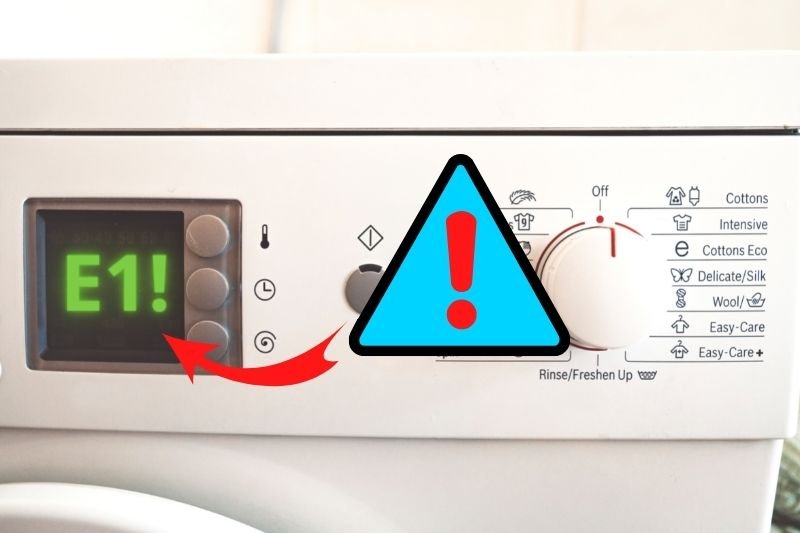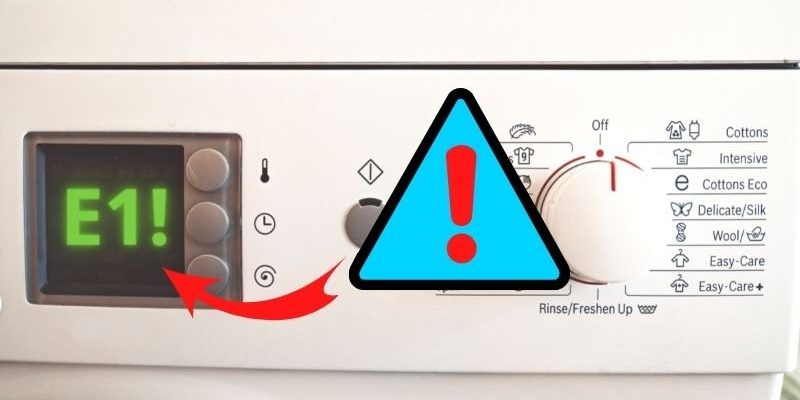
An error code like E1 is your washing machine’s way of telling you something’s not quite right. Think of it as your car’s check engine light—a warning that needs your attention. When your GE washing machine displays an E1 message, it’s signaling that there’s a problem with water not entering the machine properly. Much like a garden hose that’s kinked or a faucet that’s turned off, something is blocking the water from flowing into the machine as it should.
Understanding the E1 Error Code
So, what exactly does the E1 error code signify? In simple terms, the E1 code means there’s an issue with water supply to the washing machine. This could be due to a variety of reasons, such as low water pressure, a clogged filter, or a malfunctioning water inlet valve. It’s like trying to fill a bathtub with the tap only half open—frustrating and ineffective.
First off, let’s talk about water pressure. Just like trying to drink a smoothie through a faulty straw, if the water pressure in your home is too low, your washing machine won’t be able to get the water it needs to operate properly. As a result, the machine will show an E1 error because it’s not receiving the water as expected.
Another common cause of the E1 error can be a clogged filter. Over time, tiny bits of debris or mineral deposits can build up and block the smooth flow of water into your washing machine. It’s similar to a clogged drain—it doesn’t stop the water completely but certainly slows it down to a trickle, enough to trigger the E1 error.
What Causes the E1 Error Code?
The most common culprit causing the E1 error is a problematic water inlet valve. Imagine trying to water your plants with a hose that won’t turn on properly. If the inlet valve is defective, it won’t let water flow into the washing machine, causing the E1 error to appear. Over time, wear and tear or mineral deposits might damage the valve, leading to incomplete water flow.
Alternatively, an improperly installed hose connection can be another reason for the error code. If hoses are kinked or loosely connected, it disrupts the water flow. Picture a roadblock on a highway; it just stops everything in its tracks, right? Similarly, a kinked hose prevents water from reaching the machine efficiently, resulting in the E1 message flashing on your control panel.
Lastly, the E1 error might arise from something as simple as the washing machine being overloaded. If a washing machine is packed too full, it can affect the machine’s balance and operation. This might cause the machine to register an error, as it struggles to evenly distribute water among too many clothes.
The Consequences of Ignoring the E1 Error
What happens if you decide to ignore the E1 error? Well, ignoring it could lead to a cascade of other issues. Without addressing the root cause, your washing machine might start to experience more severe problems. Imagine a small snowball rolling downhill and picking up more snow—it grows bigger and bigger, turning into an avalanche of troubles.
Persistent ignoring of the error can lead to water damage inside the machine. Continual attempts to operate without fixing the water flow issue may cause leaks, leading to potential flooding within your laundry space. Additionally, your clothes might not get washed properly, resulting in detergent residue and unsatisfactory cleaning results. Besides, there’s the potential wear and tear on other parts of the washing machine as it struggles to operate under less-than-ideal conditions.
If you repeatedly disregard the E1 error, you may eventually face a situation where the machine stops working altogether. The inconvenience and cost of repairing or replacing your washing machine can far outweigh the effort of addressing an error as soon as it pops up.
Steps to Resolve the E1 Error
Now that we’ve discussed why ignoring the E1 error isn’t the best choice, let’s focus on how to fix it. To start, check your water supply. Make sure the taps are fully open and there is adequate water pressure. If the water supply is the problem, getting it fixed could resolve the error right away.
Next, inspect the water inlet hoses. Ensure they are not kinked or obstructed, and that they’re connected securely to both the water supply and the washing machine. A simple repositioning of the hoses might solve the issue, much like unkinking a bent garden hose to get the water flowing again.
Another step is to clean the filter. Disconnect your washing machine from the power supply, remove the water inlet hoses, and check the filters for any debris or buildup. Cleaning these filters can restore proper water flow into your machine. It’s a bit like cleaning out a coffee filter to ensure a smooth brew.
Finally, if these simple fixes don’t resolve the problem, consider calling a professional. They can diagnose other potential mechanical issues like a faulty water inlet valve that might need repair or replacement. Remember, sometimes it takes a skilled hand to navigate complex machinery.
Preventing Future E1 Errors
Prevention, as they say, is better than cure. To avoid future headaches with error codes, make a habit of regularly checking and maintaining your machine. Periodically clean the filters and ensure adequate water pressure in your home. Just like regularly checking the oil in your car keeps it running smoothly, regular maintenance can keep your washing machine in top shape.
Consider scheduling routine inspections by a professional to catch any potential issues before they escalate. This proactive approach can prevent disruptions and prolong the life of your washing machine. It’s like having regular health check-ups to stave off illness and keep everything functioning smoothly.
Stay informed about your appliance’s user manual and follow the recommended guidelines for machine use. Adhering to these recommendations not only prevents errors but also ensures optimal performance and longevity for your washing machine.
By understanding and responding to the E1 error code, you’re not just fixing a problem, you’re safeguarding your investment and ensuring that your washing machine continues to make life easier, just as it should.
